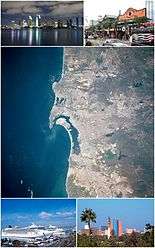Avenida Revolución
Avenida Revolución (Spanish for "Revolution Avenue") is the tourist center in Tijuana, Baja California, México. It is a main thoroughfare of the historic downtown of Tijuana, officially called the Zona Centro, which forms part of the Delegación Centro or Central Borough of Tijuana.[1]
History
It was the first paved road of the 20th century, an important center of economic development, and a tourist attraction notable for the visitors who crossed the border daily from San Diego, California. The city's most remarkable development was during the Prohibition period and after World War II, since it was considered a center of prohibited entertainment for inhabitants of the United States. During this time Caesar salad was invented at the restaurant of Hotel Caesar. Currently, the street is the center of tourist activity. The long avenue is home to several distinct attractions, from cantinas and table dance bars to numerous dance clubs and art galleries.
Location
The "Revu" begins at the intersection with Avenida Internacional (which runs across the Mexico-United States border) and ends in the Torre de Tijuana where the street intersects with Blvd. Fundadores and the name changes to Boulevard Agua Caliente, running east for many kilometers through a higher-end business district.
Popularity
Avenida Revolución has experienced many changes, and is known as the business card of Tijuana, "The most visited city in the world". It was known for its famous cantinas including, "La Ballena", the largest bar in the world when it was open. The city was popular with American Navy sailors until the United States Navy prohibited sailors from visiting Tijuana.[2] From 1989 to 1994 the Avenida's Baby Rock discothèque was the claimed to be #1 club in the world based on gross revenues,[3] before becoming in 2012 the Onixeus. Adjacent to the Avenida Revolución is the Zona Norte, the town's red light district.
A popular tourist attraction is taking a picture with a Tijuana Zebra, which is really a donkey painted to look like a zebra, but only a few are left. At night, most of the shop keepers close as some night club and bars open. Numerous pharmacies are frequented by Americans who cross the border in search of cheaper medicines. The Avenida was remodeled a few years back to accommodate more people walking around and less cars driving by.
See also
| Wikimedia Commons has media related to Avenida Revolución. |
References
- ↑ Official map website of the Tijuana City government
- ↑ Los Angeles Magazine - Jun 2000 - Page 106 "The heart of Old Tijuana is the Avenida Revolucion, anchored by its gorgeous Spanish-style Fronton Palacio, or Jai Alai Palace. The broad boulevard is lit up Vegas style block after block, with one fancy discotheque-bar after another. There's a Hard Rock, part of the global chain, and a Baby Rock, no relation; the name is a reference to its Flintstones decor."
- ↑ hollywoodoutbreak 28 March 2011
